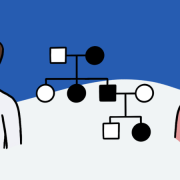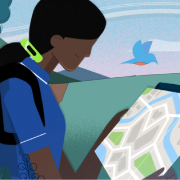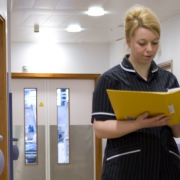Hidden genomics in health visiting
In this feature article for the 2023 #GenomicsConversation week, we explore the vital role that health visitors play in unlocking the potential of genomics for patients
Health visiting might not be the first profession that springs to mind when someone mentions genomics, but health visitors have an increasingly important part to play in identifying who might benefit from testing, as well as caring for those children and families who have received or are waiting for a diagnosis.
We spoke to Institute of Health Visiting practice development lead, Sally Shillaker, who gave us four tips on how health visiting colleagues can unearth hidden genomics in their day-to-day work.
Be curious about genomics
Health visitors are in a unique position: we’re the only healthcare professionals who offer a universal service to all babies, young children and their families through the Healthy Child Programme. This means that we see families, at home and in clinic, during their child’s preschool years.
During our contact with a family, for example in a development review, we might notice that a baby is not reaching the development milestones as expected. This might have also been flagged to us by the parents. Here, we can draw on our professional curiosity to find out more: explore what the baby is finding difficult and how their development has been going, talk to the family about any concerns they may have and revisit their developmental progress. By doing this, we can intervene early and offer support to families who may require genomic investigations. Without a health visitor’s input, it is possible that a child’s needs may not be recognised and the ‘hidden’ testing they require might not come to light until much later.
Listen to wider conversations
Health visitors lead on, and deliver, the Healthy Child Programme for children up to five years of age. Within this programme, we have many opportunities to hear and act on important information that families might share in conversations. This might lead to further assessment and signposting to more expert genomic advice.
For example, during pregnancy, we meet mothers and fathers, or co-parents, to discuss the transition to parenthood, the early developmental needs of babies and the family’s support needs following the birth. During this meeting, families may talk about their experiences in this pregnancy, their own health or that of other family members. These conversations may bring information to the surface that may be helpful to explore with professionals with genomic expertise. By playing our part, listening closely and signposting out when we notice something in the family history, we help to uncover information that, when communicated with colleagues, can make a huge difference.
Build trust with families
Families will often get in touch with us with questions outside of planned visits. They may have concerns about their baby’s feeding, or seek advice about an illness or an aspect of their child’s behaviour. Because we establish trust over months and years, health visitors are often the first healthcare professional that a family speaks to. They know us, trust us and have the means to contact us. Asking for help can take a lot of courage, and it’s important that we nurture a relationship with the family so that they are comfortable sharing information with us. After all, this information could end up making all the difference in regard to genomics. Our fast identification and referral for a potential condition could give a child new avenues for treatment, support parents with future pregnancies and even trigger screening for the wider family.
Health visitors provide continuing support to a child and family during the diagnostic odyssey (a term used in genetics and genomics to describe the often long period of time it can take for a patient to receive a diagnosis for their condition) and after a diagnosis has been made.
Appreciate the environment
Being invited into a family’s home is a real privilege. It can allow us to have more open and candid conversations with family members and offers parents an opportunity to speak about the things that matter most to them. Health visitors work in partnership with the family to identify strengths and concerns, as well as priorities and plans for action. A parent might mention that a member of their wider family has or had a specific health condition or presentation. These pieces of information can help to build up a picture of the family history, which can be crucial when thinking about genomics.
Working within the home can also allow us to make observations that otherwise wouldn’t be possible, for example seeing a child playing happily with a toy on one visit but, on a subsequent review visit, observing a change in their ability. For example, struggling to play with that toy because they are now less mobile. This observation can be explored with the family in the home and a plan of care can be agreed – perhaps a referral to a paediatrician would be appropriate or further liaison with other healthcare professionals is needed.
As health visitors, we have such an important role to play in uncovering ‘hidden genomics’ for our families, as well as supporting those already on a diagnostic odyssey or living with a genetic condition. As the power and potential of genomics increases, so too will our ability to help.
For more information on how health visitors can upskill in genomics, visit the Institute of Health Visiting website and read the Genomics Good Practice Points – a series of documents designed to provide a foundation of genomics learning for practice.









